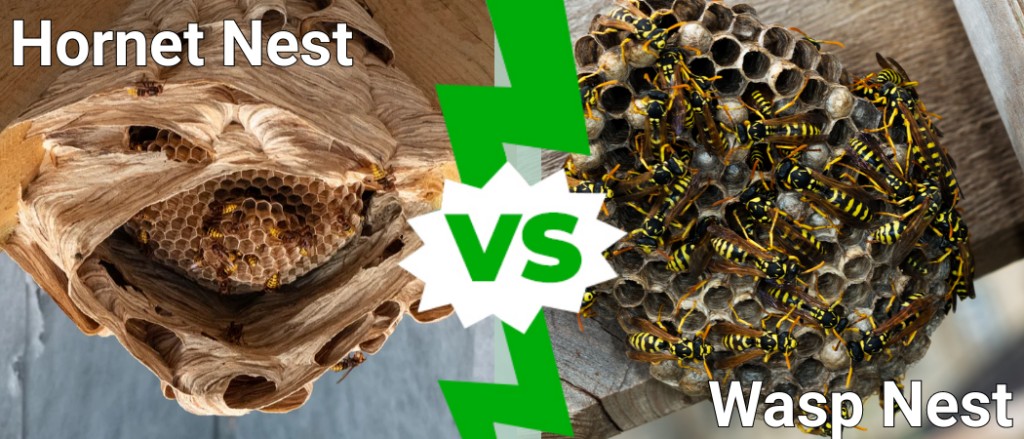
The post Hornet Nest Vs Wasp Nest: 4 Key Differences appeared first on A-Z Animals.
When buzzing, stinging insects show up, most of us care more about staying out of their way than figuring out exactly what they are. But here’s a key detail: hornets are actually just one type of wasp. In this guide, we’ll break down the differences (and the common mix-ups) between hornet nests and wasp nests. Knowing how they differ not only helps with identification but also highlights just how fascinating these insects can be, even if you’d rather admire them from a safe distance.
This post was updated on September 12, 2025 to clarify hornets as a subset of wasps, bald-faced hornets as yellowjackets, the substance used by hornets for nest building, the Asian giant hornet’s US presence, and flashlight warning for DIY removal.
Comparing a Hornet Nest and a Wasp Nest

There is a bit of confusion around the terminology for hornets, wasps, and all the other stinging bugs that live in our yards. To quickly clear things up, the word “wasp” is the general scientific category for all of the stinging bugs that aren’t bees.
Mud daubers, yellow jackets, all species of hornets, paper wasps, and more, all belong in the wasp category. Since “wasps” is a broad term, we went ahead and listed three of the most common wasps that are found in the United States: hornets, paper wasps, and mud daubers.
The biggest differences between hornet nests, paper wasp nests, and mud dauber nests are physical size and shape, material, and colony size. Hornets have the largest nest out of the three, often as large as a basketball. Paper wasps are hexagonal “umbrellas” that are usually only a few inches wide. Mud daubers live in a 3-4 inches long tube.
Materially, hornet nests vs. paper wasp nests are very similar, with the mud dauber being the outlier. Hornets and paper wasps chew wood fibers and mix them with their saliva, making a papery building material. Mud daubers, as their name implies, use clay and mud.
Finally, the other major difference is the colony size within the nest. Paper wasps and hornets are social and live in large colonies, while mud daubers are solitary wasps.
Check out our Video on YouTube
Hornet Nest Vs Wasp Nest: Size
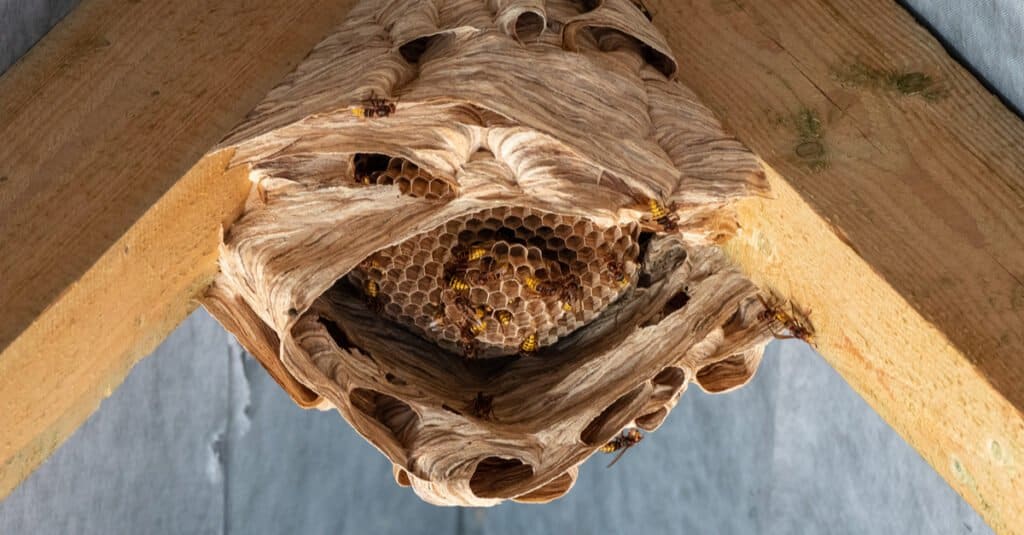
Hornets have larger nests than most wasps, especially solitary wasp species.
©Istvan Csak/Shutterstock.com
Without a doubt, hornets have the largest nest on our list. When you see a hornet’s nest, you are usually pretty certain what you are looking at. They start off small, but once they are fully built, they average the size of a basketball, although they can get much bigger. These large nests have a single opening and are filled with chambers and tubes, all with different purposes.
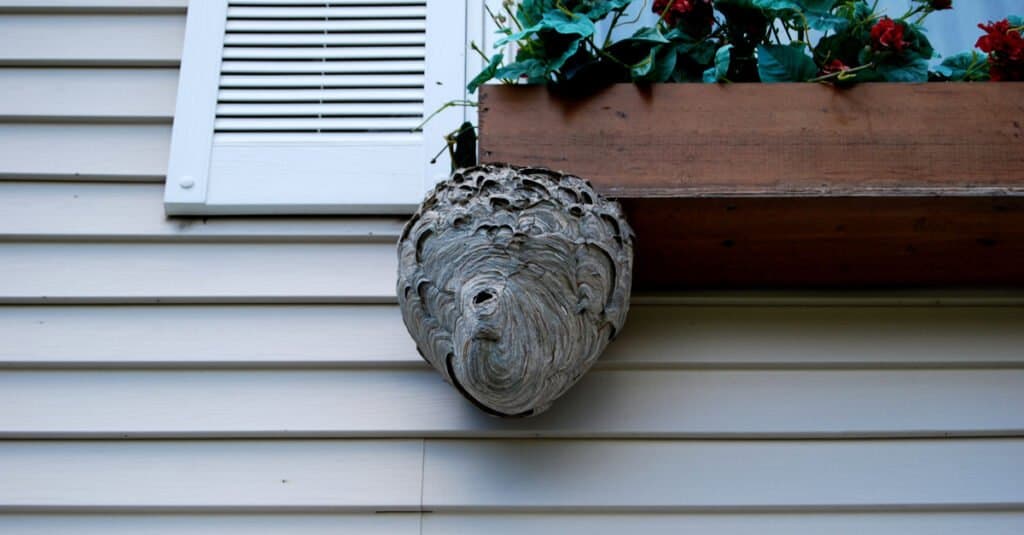
When completed, hornets nests have a single opening that’s visible
©Klod/Shutterstock.com
Paper wasps are among the most common wasps humans are likely to see, though yellowjackets are also very frequently encountered, especially around human activity. Their nests are umbrella-shaped, as if an umbrella without a handle were floating in the air. They are much smaller than a hornet’s nest, usually measuring 6-8 inches in diameter, though some may be smaller or larger depending on the species. The underside of the umbrella is filled with hexagonal cells that wasps duck in and out of.
These cells are where the queen lays eggs. There is one queen per nest and she lays one egg at the bottom of each cell. The other wasps in the nest prepare the cells for egg laying and bring food for the queen and the larvae when it hatches. When the larvae reach the pupation stage, the adults seal over the cell entrance creating a cocoon for the larvae. When the new wasp is fully developed, it will chew through the paper covering the cell and takes its place as an adult member of the hive. The cell is then cleaned out and prepared for the queen to lay another egg.
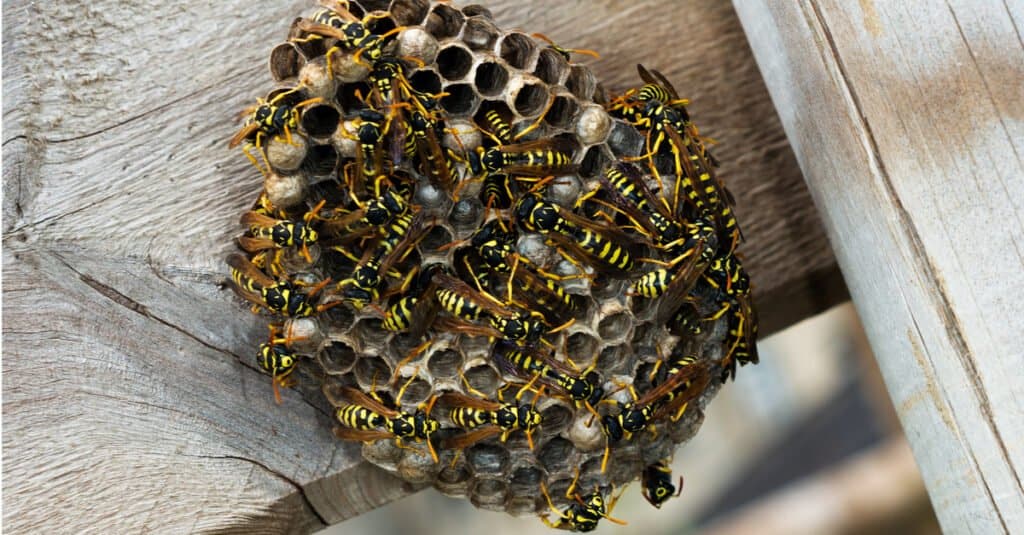
Paper wasp nests are much smaller than hornet nests.
©Sarah2/Shutterstock.com
Interestingly, There are tiers of the same structure hidden inside the large, basketball-sized, hornet’s nest. While the behavior and shape of wasps, hornets, and bees vary widely, they all use the same hexagon-shaped cells to raise their young.
Mud daubers have the smallest nests of the three. They build small tubes, usually only 2 inches wide and 4-6 inches long. They will occasionally add to them, but they are still smaller, mostly because they are solitary wasps.
Hornet Nest Vs Wasp Nest: Material
Material is a great way to distinguish certain wasp nests from one another. A hornet’s nest appears papery, mostly because it is! Hornets chew wood fibers into a pulp and then add their saliva to it. This papery pulp is their primary building material. Layered together, it is strong and durable in most weather conditions.
Similar to hornets, paper wasps also chew wood pulp and mix it with their own saliva to create a building material. Instead of layering it into huge balls as hornets do, however, they turn it into hexagonal columns and passages with an overall smaller form factor.
Mud daubers are unique in their nest building. As their name implies, they find dirt and clay, mix it with their saliva, and plaster it onto surfaces. Like human constructions using mud, these structures are rather durable and can withstand a lot of environmental conditions.
Hornet Nest: Different Types
Until recently, the only species of true hornet established in the U.S. was the European hornet. However, the Asian giant hornet (“murder hornet”) has also been detected in the Pacific Northwest since 2019 (though not widespread). One well known stinging insect, the bald-faced hornet, is not a true hornet at all, but an aerial yellowjacket.
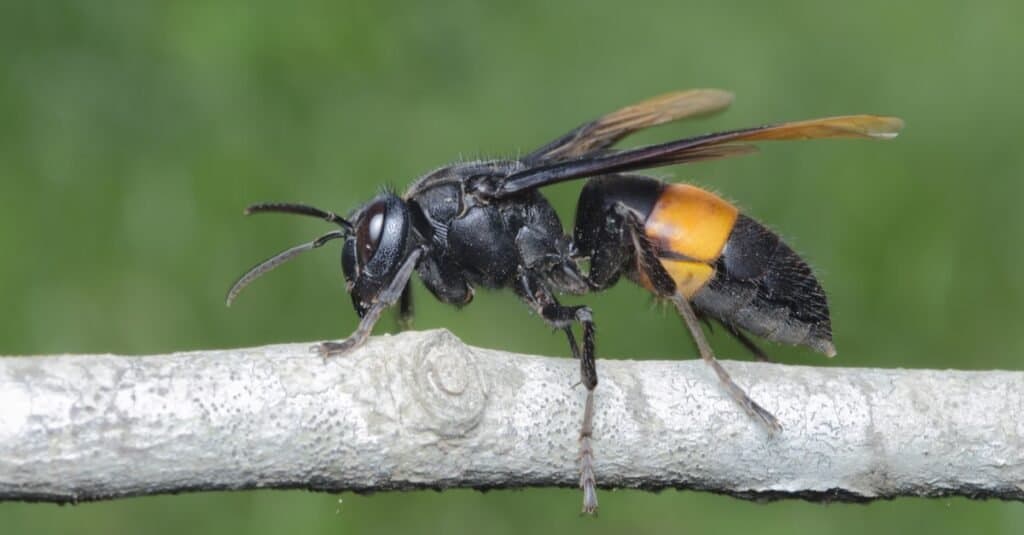
Hornets chew wood fibers to use in their papery nests.
©Ruzy Hartini/Shutterstock.com
Bald-Faced hornet nests
Bald-Faced hornets (actually a yellowjacket) nest in trees or large bushes at least a few feet off the ground. These pests may also hang their nests from roofs of buildings or houses. A bald-faced hornet hive is egg-shaped and can reach up to two feet in length! Overhangs are typical sites for this kind of nest.
European hornet hives
European hornets nest in open walls or tree cavities. Though they typically prefer trees and shrubs, they sometimes use manmade structures, residing in attics or sheds. These pests hide their nests in dark, hollow spaces, and only a small section of the nest may be visible to the human eye. Unlike the bald-faced hornet, European hornets build the entrance to their nest more than six feet above the ground.
Hornet Nest Vs Wasp Nest: Colony size
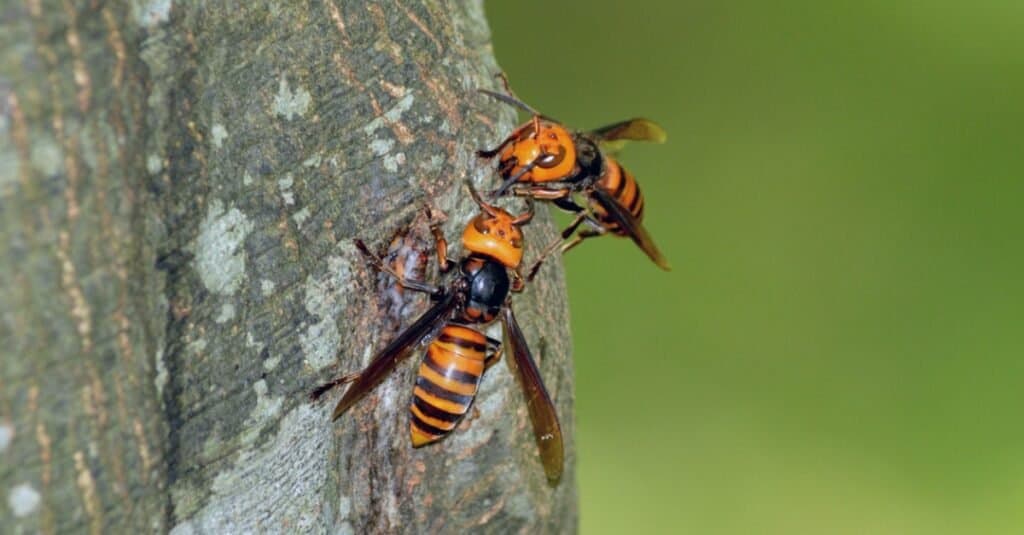
Hornets and most wasps use wood fibers and saliva to make their nests. Mud daubers use clay or mud to make theirs.
©iStock.com/kororokerokero
Colony size and capacity is another important factor that distinguishes certain nests from one another. Hornets have the largest nests of the three and subsequently have the largest colonies. On average, a European hornet’s nest can house 100-700 hornets, while some species, like the Asian giant hornet, can have colonies with up to 1,000 workers. All the more reason not to poke the hornet’s nest!
Paper wasps have smaller nests and smaller colonies. On average, a paper wasp nest will have between 20 and 100 individuals, depending on the species and environmental conditions. In the winter, most of them die out and the cycle restarts. In some places, however, a wasp nest can become truly massive if left alone.
Mud daubers are unlike the other two in that they are known as “solitary” wasps. Solitary wasps don’t have associated colonies and are known for their hunting ability and paralytic venom. Mud daubers almost exclusively eat spiders and will paralyze them with a sting, lay an egg inside of them, and then seal them in a mud tube to grow their young.
Hornet Nest Vs Wasp Nest: Location
Hornets generally prefer large branches of trees that can support the weight of their nests. If a suitable tree isn’t available, they are ok with anything that has covering and room underneath for growth.
Paper wasps are less choosy than hornets. Their only real stipulation is that the location is semi-covered. As a result, humans often find their nests on their eaves, under porches, and in other places they really don’t want them.
Mud daubers have similar preferences to paper wasps in that they like covered areas. You can find them under bridges and in outdoor gazeboes, but they will live pretty much anywhere there is dirt and a place to eat spiders.
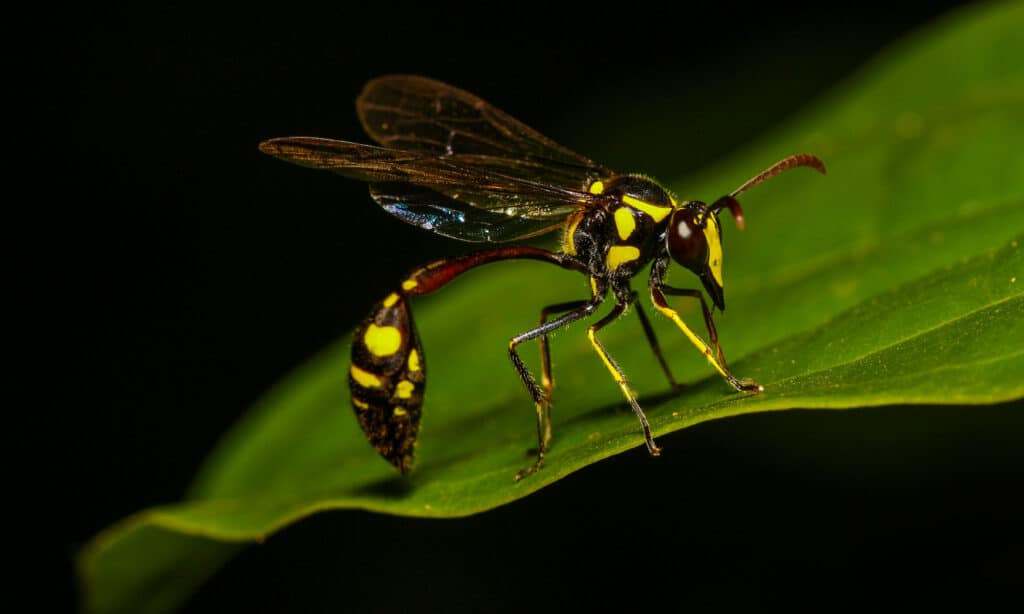
Mud daubers make their nests in a tube made of mud that is close to spiders.
©Preecha Ngamsrisan/Shutterstock.com
How Do You Get Rid of a Hornet’s Nest?
Now that you have determined what kind of nest is in your backyard, you now may want it removed. Call a professional pest control company to get the job done safely. If you dare to brave the job yourself, there are steps you can take to avoid a dangerous situation. Have all of the supplies ready before you begin, such as a light source, protective gear, trash bag, pole, and ladder. Wait until nighttime when hornets are less active. A flashlight can help you see the opening, but hornets are also drawn to light. Professionals recommend using red filters or very dim lights to avoid drawing them out. Spray inside of the nest and avoid the area if they begin flying. Make sure all hornets are dead before you try to remove. It is a good idea to watch the next day to see if any are coming and going; spray again that night. If all of the hornets are dead, remove the nest with a pole, quickly disposing the nest in a trash bag. The nest will be full of insecticide, so make sure to seal the bag and dispose it safely away from pets and people.
Summary of Hornet Nest Vs Wasp Nest: 4 Key Differences
| Category | Hornet’s nest | Paper Wasp’s nest | Mud dauber’s nest | |
|---|---|---|---|---|
| 1 | Size | The average size of a basketball, sometimes larger | 6-8 inches, hexagonal design | 2 inches wide, 4-6 inches long, long tubular design |
| 2 | Material | Paper-like material made from chewed wood fibers and saliva | Paper-like material made from chewed wood fibers and saliva | Mud or clay mixed with spit |
| 3 | Colony size | 100-700 workers plus a queen | 20-30 insects | 1 wasp per nest |
| 4 | Typical location | Tree branches, eaves, shrubs | Eaves, branches, pipes, or any sheltered area | Eaves, covered areas, porches |
The post Hornet Nest Vs Wasp Nest: 4 Key Differences appeared first on A-Z Animals.
September 12, 2025 at 05:02PMColby Maxwell
.jpeg)
.jpeg)

0 Comments